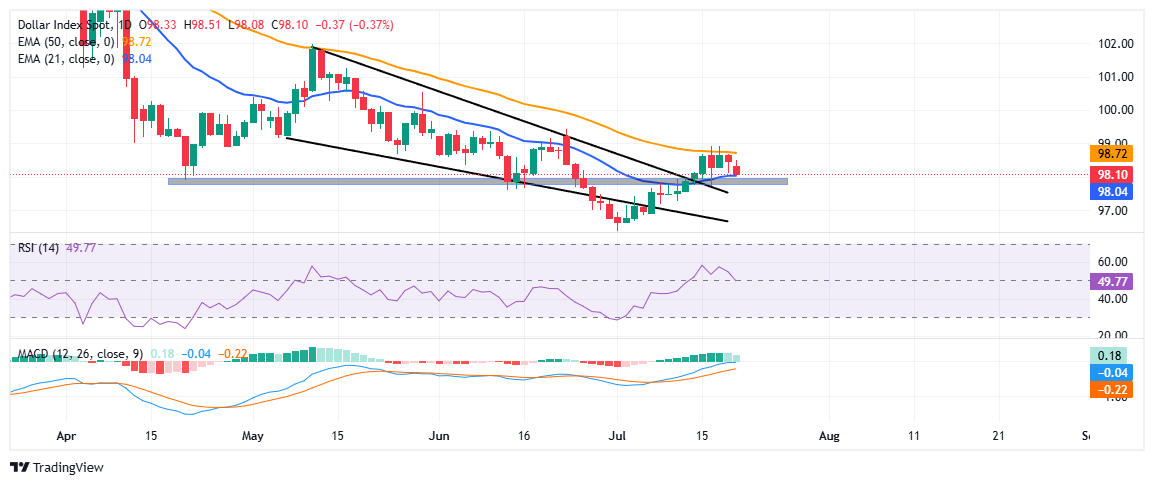US Dollar under pressure amid tariff risks, Fed uncertainty

- The US Dollar starts the week under pressure, slipping against major currencies on Monday.
- Despite solid US economic data, the DXY remains capped below the key 99.00 resistance.
- The DXY US Dollar Index is hovering above critical support near 98.00, showing signs of fading momentum.
The US Dollar (USD) kicks off the week on the back foot, slipping against major currencies in Monday trading. Investors are reacting to renewed trade tensions ahead of the August 1 deadline and a generally cautious market sentiment. Despite mostly solid US economic data lately, the Greenback is feeling the heat from ongoing uncertainty surrounding the US President Donald Trump administration’s ramped-up tariff threats and increasing political pressure on the Federal Reserve (Fed) to cut interest rates.
Speaking on CNBC Monday, Treasury Secretary Scott Bessent launched a sharp critique of the Federal Reserve, stating that it’s time to “examine the entire institution and whether they’ve been successful.” His remarks added to growing unease about potential political pressure on the Fed, denting confidence in its independence and casting uncertainty over the policy (DXY) broke out of a falling wedge pattern last week, hinting at a potential bullish reversal and pushing the index to a four-week high of 98.93 on Thursday. But the rally lost steam just shy of the key 99.00 level, which continues to serve as strong resistance. Since then, the DXY has been stuck in a tight range between 98.00 and 99.00, reflecting a market that’s hesitant to commit amid ongoing trade tensions and uncertainty over the Fed’s next move.
On the downside, the 97.80-98.00 zone has become a critical support area, aligning with the 21-day Exponential Moving Average (EMA) at 98.04 and the upper boundary of the former wedge pattern, which is now acting as a support level. This zone is critical to maintaining the bullish breakout structure. On the upside, the 50-day EMA, currently at 98.72, has consistently capped intraday advances, keeping the index in check throughout the last week.
The Relative Strength Index (RSI) on the daily chart is hovering near the neutral level, signalling a lack of momentum, while the Moving Average Convergence Divergence (MACD) indicator is showing signs of weakening, suggesting continued consolidation unless a clear catalyst emerges.
Fed FAQs
Monetary policy in the US is shaped by the Federal Reserve (Fed). The Fed has two mandates: to achieve price stability and foster full employment. Its primary tool to achieve these goals is by adjusting interest rates.
When prices are rising too quickly and inflation is above the Fed’s 2% target, it raises interest rates, increasing borrowing costs throughout the economy. This results in a stronger US Dollar (USD) as it makes the US a more attractive place for international investors to park their money.
When inflation falls below 2% or the Unemployment Rate is too high, the Fed may lower interest rates to encourage borrowing, which weighs on the Greenback.
The Federal Reserve (Fed) holds eight policy meetings a year, where the Federal Open Market Committee (FOMC) assesses economic conditions and makes monetary policy decisions.
The FOMC is attended by twelve Fed officials – the seven members of the Board of Governors, the president of the Federal Reserve Bank of New York, and four of the remaining eleven regional Reserve Bank presidents, who serve one-year terms on a rotating basis.
In extreme situations, the Federal Reserve may resort to a policy named Quantitative Easing (QE). QE is the process by which the Fed substantially increases the flow of credit in a stuck financial system.
It is a non-standard policy measure used during crises or when inflation is extremely low. It was the Fed’s weapon of choice during the Great Financial Crisis in 2008. It involves the Fed printing more Dollars and using them to buy high grade bonds from financial institutions. QE usually weakens the US Dollar.
Quantitative tightening (QT) is the reverse process of QE, whereby the Federal Reserve stops buying bonds from financial institutions and does not reinvest the principal from the bonds it holds maturing, to purchase new bonds. It is usually positive for the value of the US Dollar.
